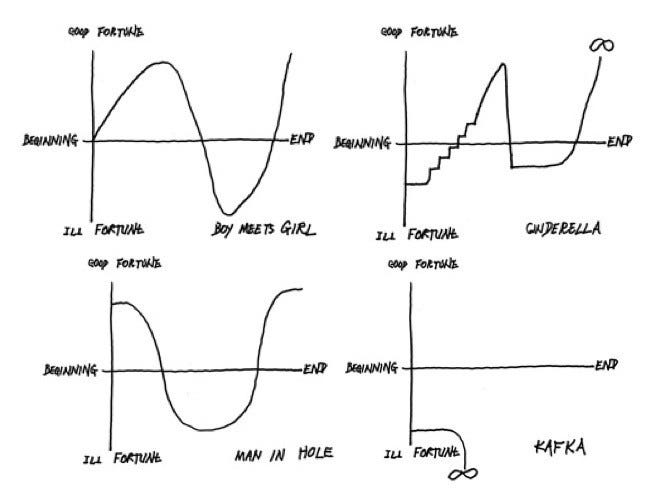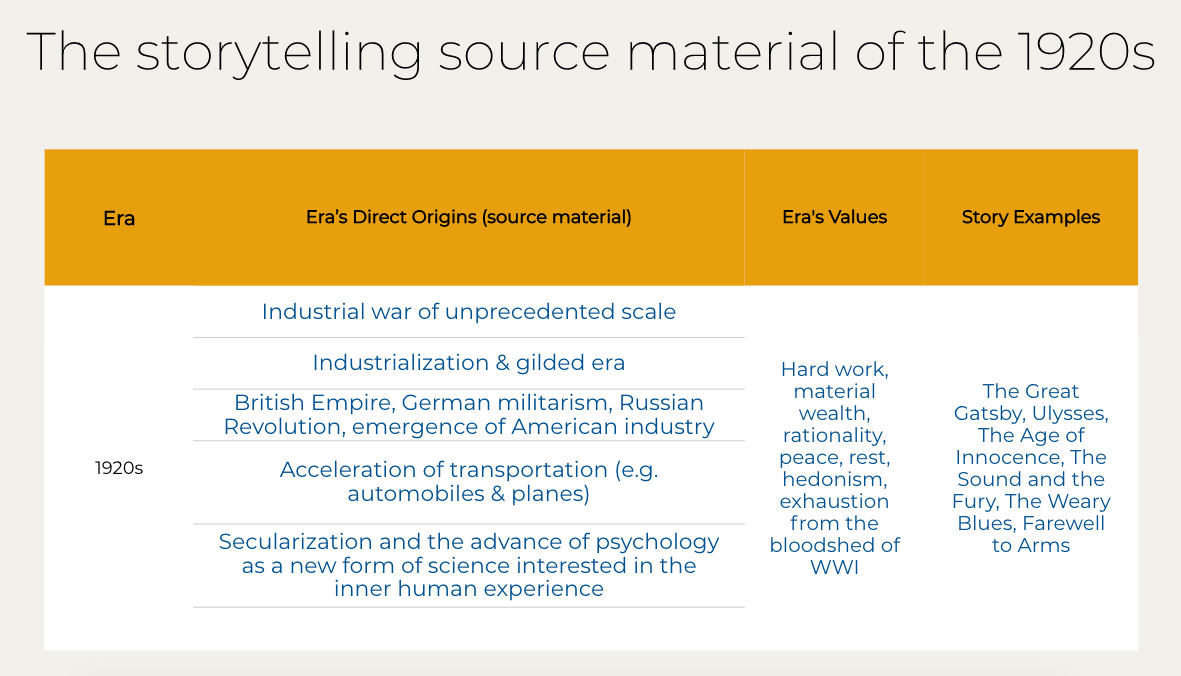Tell a Big Story (2)
Genesis, 20th century dystopia, 90's film: Formative Stories & the Origins of Storytelling Source Material
This is Part 2 of a 2-part post on storytelling. In considering these two posts over the last several weeks, I’ve been struck by Venkatesh Rao’s description of a Terry Pratchett term ‘narrativium.’ Rao writes, narrativium is “the elemental stuff of storytelling that infuses stories; the mind-stuff that makes us care about being in the world, rather than merely capable of it.”
In the first part of this post, I described a Silicon Valley CEO’s advice to me that I needed to tell a bigger story, and I considered the example of a former colleague at a career crossroads.
I attempted to explore these personal stories against the backdrop of 3 writers whose work has continued to shape my understanding of storytelling:
Yuval Harari’s explanation of why we tell stories
Joseph Campbell’s theory of the hero’s journey as the primary structure underpinning how we tell stories
Nancy Duarte’s observations on the patterns of good storytelling, especially in a business context
I didn’t explore Vonnegut’s “the shape of stories,” but a friend suggested that it would have been a good addition, and this video is a delight.
In part 2 of this exploration, I want to touch on the idea of storytelling source material as the foundation from which values emerge and lives are shaped.
To do this, I want to examine the formative stories of a group of 30-somethings and touch on the degree to which this control group has been influenced by motivational tales versus cautionary tales.
The Source Material of our Stories
In his recent essay Shadowland, Venkatesh Rao juxtaposes the world of today and the world of the early 1920s and investigates how the source material for generational value systems informs the tendencies and priorities of an era's storytellers.
He writes, "To understand the new storytelling culture that emerged in the 1920s, it is necessary to look into its origins."
For Rao, there are obvious comparisons to the 2020s, but given we have not yet lived through them, it remains to be determined how our immediate origins will impact our values and the stories that shape them.
The Stories of our Youth
In a recent book club meeting in review of Christopher Booker's 7 Basic Plots, someone asked the group, "could we go around the room and talk about the most formative stories in each of our own lives?"
The book club consists of 6 men in their 30’s. All of us were born in the 1980s, grew up in the United States, and moved into the workforce in the aftermath of the 2008 recession. When the question was posed, I felt an immediate sense of intrigue at the opportunity to better understand the stories that had most influenced each of us.
The source material for the first 2 participants is grounded in the religious canon of Judeo Christianity.
Participant A – the story of Adam and Eve, for its suggestion that the search for knowledge and a fall from grace are intractable.
Participant B – the story of Abraham and the sacrifice of his son Isaac, for its suggestion that there are times in life when leaps of faith must replace rationality.
The source material for the other 4 participants is grounded in the canon of 20th century, western literature, with each story written after 1900, and 6 of the 8 stories written after 1945.
Participant C – the stories of Brave New World, 1984, and Lord of the Flies for their reminders to search for your own individuality; to write the record in your own way.
Participant D – Somerset Maugham's Of Human Bondage, for its reminder that a life spent in the endless pursuit of status is a life susceptible to great unhappiness.
Participant E — The Phantom Toll Booth for its reminder to seek wisdom and enjoy the seeking; and All the King’s Men for its suggestion that no one can stand to the side of life, that we are all connected in a great spider web of actions and consequences, and that in America, the record is written and re-written by those brash talkers who “go out of history and into history.”
Participant F – Forest Gump and Dances with Wolves for their reminders to accept the call and to try to find the "path of the true human being" along the way.
To Rao's point, understanding when stories are published or created is important for considering how different eras inform, and are informed by, the narrative responses to the inhabited world.
And so listening to my book club friends identify the most formative stories in their lives, and in thinking through my own, I thought about the source material from which each of our stories were drawn, to what those stories were created in response, and whether the authorial intent was caution or motivation.
What emerges is an intriguing picture.
Notably, only 3 out of 10 stories are motivational in nature.
6 out of 10 were written after WWII, which is still the key shaping event of the world order we inhabit today. Of those 6, again just a third were motivational in nature.
One of the questions that emerges for me is the degree to which this tiny sample size suggests that as a society, we bias more towards inducing a fear of failure than we do toward inspiring a sense of wonder.
I’m particularly curious about what this observation implies about our values in the context of raising children, building companies, and establishing policies that are effective in the context of 21st-century challenges, and may come back to this thread in a future post.
In the meantime, perhaps in a very small way, this picture may provide calibration for the events and changes that will most inform the stories we appropriate for making sense of our lives and for mirroring to ourselves the context of our businesses, our citizenship, our families, and our inhabited era.













Really interesting stuff. At the risk of taking this to a polarizing place, which is not my intention - your analysis of the ratios of motivational vs cautionary storytelling reminded me of the rhetoric deployed in recent political campaigns. If we look at the past 6 winning U.S. presidential campaign stories for example, I would score them 4.5 (c) : 2.5 (m) with Obama’s second campaign being a split decision between motivational and cautionary tales (both of GW’s and Trump’s victories being overwhelmingly cautionary while Obama’s first and Biden’s recent approach were clearly motivational).
On the source material for storytelling in the 2020s, I can’t help but think the list of direct origins cited in the table is flawed. From my perspective, as a 40 something navel gazer, these events are themselves the stories and reflection of 2020 era value systems. Their source material being cultural events such as the Cold War (Soviet-Afghan war, Iran Contras, the war on drugs), cable TV, the internet / social media / the information economy, globalization, 9/11, the financial crisis, the de-industrialization of America, and an ever widening gap between elite and non elite socio-economic classes… This might be splitting hairs, but events like George Floyd’s murder, polarization, US/China relations, and software eating the world are the cautionary tales we should take note of and look for the motivational (redeeming) opportunities within.